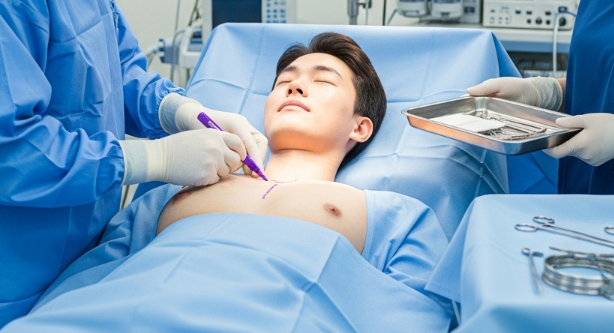Treatment Overview
Submuscular Implant Placement for MTF (Male-to-Female) Top Surgery in Korea is a gender-affirming breast augmentation procedure where implants are placed beneath the chest muscle (pectoralis major) to create natural-looking, feminine breast contours. This technique offers enhanced support, reduced risk of visible implant edges, and a more natural slope, especially for patients with minimal existing breast tissue. Korean surgeons specialize in precise implant placement, symmetry, and aesthetically pleasing chest feminization while prioritizing patient safety and comfort.
Purpose & Benefits
- Natural Breast Contours: Creates a smooth, feminine chest profile with a gradual upper-pole slope.
- Enhanced Implant Support: Submuscular placement reduces the risk of implant visibility, rippling, and sagging.
- Improved Long-Term Results: Muscle coverage enhances stability and implant longevity.
- Optimal Symmetry: Korean surgeons customize implant size and position for proportional results.
- Minimized Complications: Lower risk of capsular contracture compared to subglandular placement.
- Boosts Confidence & Gender Affirmation: Supports self-image and psychological well-being.
Ideal Candidates
- MTF patients seeking chest feminization with breast implants.
- Individuals with thin or minimal breast tissue who want natural-looking contours.
- Patients desiring a reduced risk of visible implant edges or rippling.
- Those prioritizing long-term implant stability and symmetry.
- Individuals post gender-affirming transition aiming for a complete feminine chest appearance.
Possible Risks & Complications
- Temporary swelling, bruising, or tenderness.
- Minor asymmetry or contour irregularities.
- Capsular contracture (rare with proper care).
- Infection or delayed healing (rare with proper post-op care).
- Changes in nipple or breast sensation (usually temporary).
- Implant displacement or rotation (rare with experienced surgeons).
Surgical Techniques Used
- Submuscular Implant Placement: Implant is positioned beneath the pectoralis major for natural contour and support.
- Incision Options: Inframammary, periareolar, or transaxillary approaches, based on patient anatomy and surgeon recommendation.
- Custom Implant Selection: Tailored size, shape, and projection to match body frame and desired feminized chest appearance.
- Symmetry & Proportion: Precise measurements to ensure balanced, proportional results on both sides.
- Optional Fat Grafting: Small fat transfer may be used to enhance contour and soften upper-pole transition.
Recovery & Aftercare
- Mild swelling, bruising, and tenderness for 1–2 weeks.
- Light activities can usually resume within 5–7 days; avoid strenuous exercise or chest pressure for 4–6 weeks.
- Compression garments or surgical bras recommended to support healing.
- Follow-up visits to monitor implant position, incision healing, and overall recovery.
- Final breast appearance stabilizes after 2–3 months.
Results & Longevity
- Natural-looking feminine breast contours with smooth upper-pole transition.
- Long-lasting results due to submuscular implant support.
- Symmetrical, proportionate chest aesthetics.
- High patient satisfaction and improved self-confidence.
Treatment Process in Korea
Initial Consultation & Assessment
- Evaluation of chest anatomy, muscle thickness, and skin elasticity.
- Discussion of implant type, size, and incision options.
- Customized surgical plan to match patient goals and body proportions.
Surgical Planning & Preparation
- Design of implant placement and incision strategy.
- Pre-operative imaging or measurements for precise positioning.
Surgery Day
- Performed under general anesthesia.
- Implant inserted beneath the pectoral muscle with meticulous symmetry and positioning.
- Incision closure using fine sutures to minimize scarring.
Post-Operative Monitoring
- Instructions for wound care, garment use, and activity restrictions.
- Follow-up appointments to ensure proper healing and implant placement.
Follow-Up & Refinement
- Minor adjustments or touch-ups if necessary for optimal symmetry.
- Long-term monitoring for implant health and overall chest aesthetics.
Why Korea is a Top Destination
- Highly experienced surgeons specializing in MTF chest feminization and implant techniques.
- Clinics equipped with advanced surgical tools and preoperative planning technology.
- High success rates with natural, aesthetically pleasing results.
- Emphasis on minimizing scarring and preserving sensation.
- Personalized approach tailored to individual anatomy and patient goals.
Cost Range
The cost of Submuscular Implant Placement for MTF Top Surgery in Korea varies depending on implant type and clinic reputation:
- Silicone Implants: USD $4,000 – $7,000
- Saline Implants: USD $3,500 – $6,000
- Premium Clinics (3D Planning & VIP Care): USD $5,500 – $8,500
- Revision or Touch-Up Procedures: USD $1,500 – $3,000
Popular Clinics
- Banobagi Plastic Surgery Clinic (Seoul): Known for MTF top surgery and submuscular implant expertise.
- ID Hospital (Seoul): Offers advanced implant techniques and personalized chest feminization.
- JK Plastic Surgery Center (Seoul): Focused on symmetry, natural slope, and aesthetic finishing.
- View Plastic Surgery Clinic (Seoul): Specializes in submuscular implants for transgender patients.
- JW Plastic Surgery (Seoul): Experienced in combining implants with fat grafting for optimal results.




